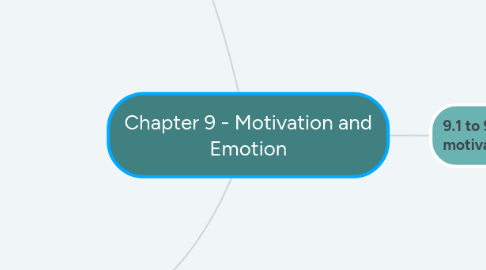
1. 9.6 to 9.7 - Why people eat
1.1. 9.6 - Physiological and social components of hunger
1.1.1. The physiological components of hunger include signals from the stomach and the hypothalamus and the increased secretion of insulin
1.1.1.1. Leptin is a hormone that when released into the bloodstream signals that the body has had enough food, reducing appetite
1.1.2. When the basal metabolic rate slows down, the weight set point increases and makes weight gain more likely
1.1.2.1. The weight set point is the particular level of weight that the body tries to remain at
1.1.3. Social components of hunger includes social cues for when meals are to be eaten, cultural customs and food preferences, and the use of food as a comfort device or as an escape from unpleasentness
1.2. 9.7 - Obesity
1.2.1. There are genetic and hormonal factors that can influence obesity
1.2.2. Maladaptive eating and overeating may also lead to obesity, as well as stress
1.2.3. Worldwide, about 18% of children and 39% of adults are obese
2. 9.8 to 9.10 - Emotion
2.1. 9.8 - The three elements of emotion
2.1.1. Emotion is the feeling aspect of consciousness, characterized by three elements:
2.1.1.1. Physical arousal
2.1.1.1.1. Physical arousal is tied to activation of the sympathetic nervous system
2.1.1.2. Behavioral elements
2.1.1.3. Subjective internal elements
2.1.2. The amygdala plays a key role in emotional processing
2.2. 9.9 - Early theories of emotion
2.2.1. Common sense theory
2.2.1.1. States that an emotion is experienced first, leading to a physical reaction and then to a behavioral reaction
2.2.2. James-Lange theory
2.2.2.1. States that a stimulus creates a physiological response that then leads to the labeling of the emotion
2.2.3. Cannon-Bard theory
2.2.3.1. Suggests that the physiological reaction and the emotion are simultaneous, as the thalamus sends sensory information to both the cortex of the brain and the organs of the sympathetic nervous system
2.2.4. Facial feedback hypothesis
2.2.4.1. Suggests that facial expressions provide feedback to the brain about the emotion being expressed on the face intensifying the emotion
2.3. 9.10 - Cognitive theories of emotion
2.3.1. Schachter and Singer's cognitive arousal theory
2.3.1.1. Suggests that both the physiological arousal and the actual interpretation (cognitive appraisal) of that arousal must occur before the emotion itself is experienced. This interpretation is based on cues from the environment
2.3.2. Lazarus's cognitive-mediational theory
2.3.2.1. Suggests that a stimulus must be interpreted (appraised) by a person in order to result in an emotional reaction and then an appropriate physical reaction
3. 9.1 to 9.5 - Understanding motivation
3.1. 9.1 - Defining motivation
3.1.1. Motivation is the process by which activities are started, directed and continued so that physical or psychological needs are met
3.1.1.1. Extrinsic motivation occurs when people act because of external motives or rewards
3.1.1.2. Intrinsic motivation occurs when people act because the act itself is rewarding or satisfying
3.2. 9.2 - Early approaches to understanding motivation
3.2.1. Instinct approaches proposed that some human actions may be motivated by instincts, which are innate patterns of behavior found in both people and animals. Instincts are mainly descriptions, not explanations
3.2.2. Drive-reduction approaches state that when an organism has a need, such as hunger, the need leads to psychological tension that motivates the organism to act, fulfilling the need and reducing the tension
3.2.2.1. Homeostasis is the tendency of the body to maintain a steady state and is part of drive-reduction theory
3.2.3. Primary drivees involve needs for the body, whereas secondary drives are those learned through experience
3.3. 9.3 - Psychological needs
3.3.1. McClelland's theory proposes that there are three types of needs
3.3.1.1. Need for affiliation: need for friendly social interactions and relationships with others
3.3.1.2. Need for power: having control over others and having an impact on them, status and prestige important
3.3.1.3. Need for achievement: strong desire to succeed in achieving one's goals
3.3.2. Carol Dweck's self-theory of emotion/motivation links the need for achievement to the concept of locus of control
3.3.2.1. An internal locus of control leads to more attempts to achieve and the other way around
3.4. 9.4 - Arousal and incentive approaches
3.4.1. Arousal theory
3.4.1.1. In this theory, a person has an optimal level of arousal to maintain. People who need more arousal than others are called sensation seekers
3.4.2. Incentive approach
3.4.2.1. Here, an external stimulus may be so rewarding that it motivates a person to act toward that stimulus even in the absence of a drive
3.5. 9.5 - Humanistic approaches
3.5.1. Maslow's hierarchy of needs
3.5.1.1. This begins with the basic physiological needs and ends with transcendence needs. The more basic needs must be met before the higher needs can be fulfilled
3.5.1.2. Criticisms are that there is a lack of scientific support and that the order of the needs might be different in different cultures
3.5.2. Self-determination theory is a model of motivation in which three basic needs are seen as necessary to an individual's successful development. Depending on the social context, the type of motivation existing for an action differs.
3.5.2.1. Autonomy
3.5.2.2. Competence
3.5.2.3. Relatedness
